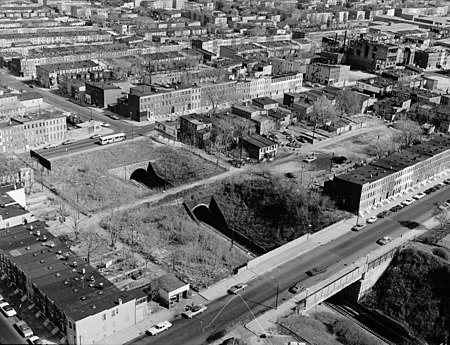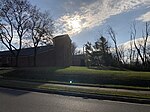Baltimore and Potomac Tunnel

The Baltimore and Potomac Tunnel (or B&P Tunnel) is a double-tracked, masonry arch railroad tunnel on the Northeast Corridor in Baltimore, Maryland, just south of Pennsylvania Station. Opened in 1873, the tunnel is used by about 140 Amtrak and MARC passenger trains and two freight trains every day, as of 2008.The 7,669-foot (2,338 m) tunnel, which passes under the Baltimore neighborhoods of Bolton Hill, Madison Park, and Upton, consists of a single tube with two tracks. It is punctuated by two open-air cuts for ventilation of exhaust fumes and smoke—Pennsylvania Avenue Opening and John Street Opening—that divide the main tunnel into three "sub-tunnels", designated (from south to north) Gilmor Street Tunnel, Wilson Street Tunnel, and John Street Tunnel.
Excerpt from the Wikipedia article Baltimore and Potomac Tunnel (License: CC BY-SA 3.0, Authors, Images).Baltimore and Potomac Tunnel
Argyle Avenue, Baltimore
Geographical coordinates (GPS) Address Nearby Places Show on map
Geographical coordinates (GPS)
| Latitude | Longitude |
|---|---|
| N 39.303 ° | E -76.6352 ° |
Address
Pennsylvania Avenue
Argyle Avenue
21217 Baltimore
Maryland, United States
Open on Google Maps










